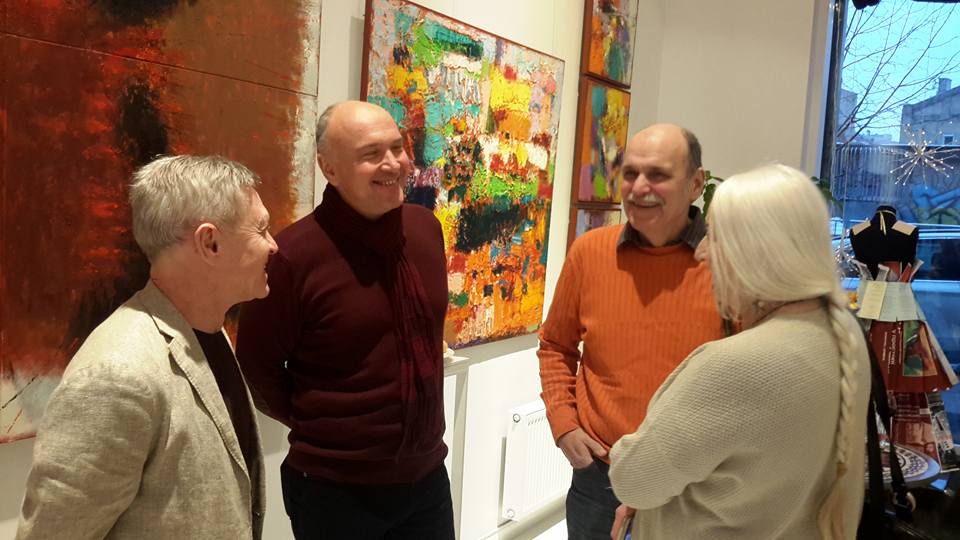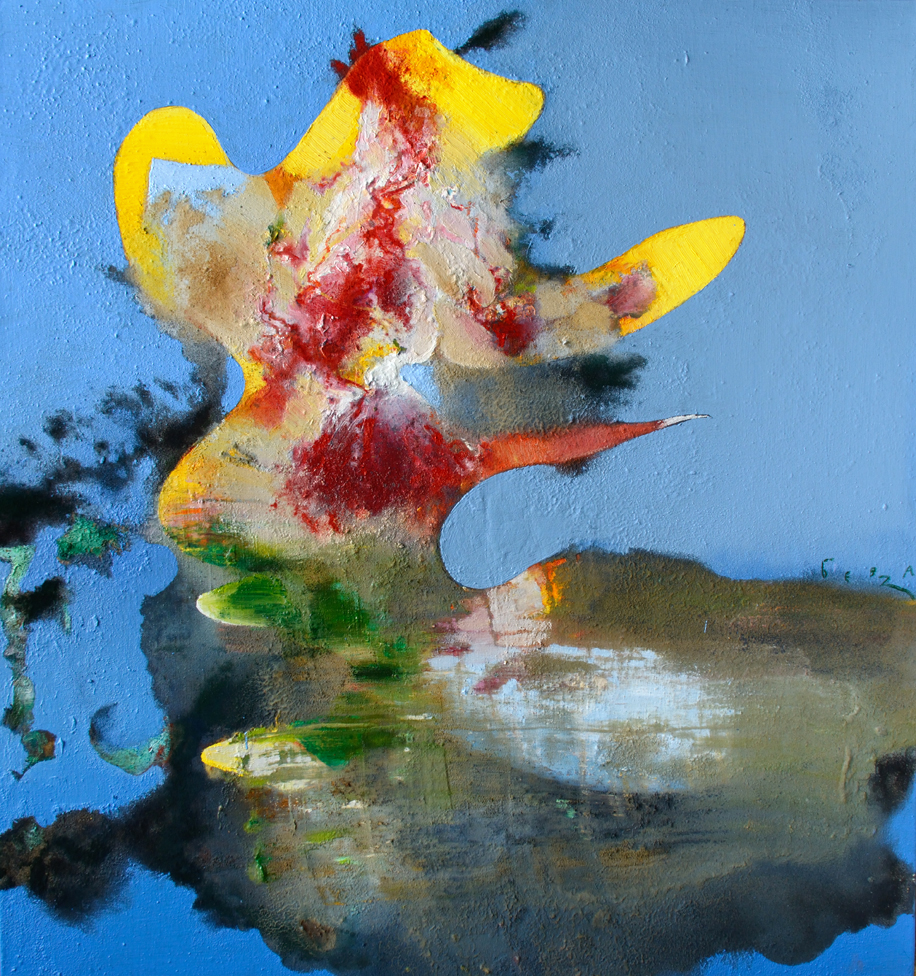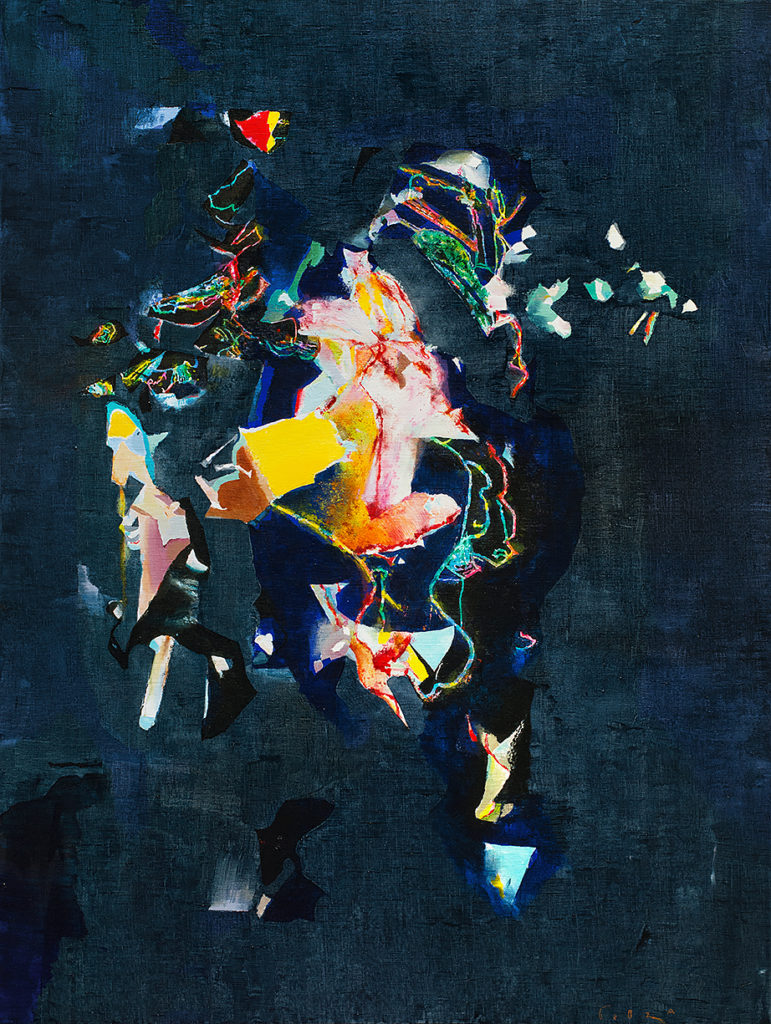Petro Bevza’s Penetration Into Dynamic Non-Objectivism
Diana Klochko
In painting there’s a term rarely used in our circles – “penetration”. A loose synonym of far more frequent “vision”, the term more often has a sexual connotation. But sometimes one may recall the word also has the broader meaning of an uncommon (especially nowadays) intellectual quality – that of perceptivity.
For me that’s the most important experience I get every time when viewing the works of Petro Bevza.
To help explain, I’ll describe what happens at the physiological level.
First: the pupils reflexively expand and eyes movement begins accelerating.
Second: the hands reach to touch the surface and sometimes – to surrealistically dive into the picture.
Third: there’s a strong urge to remain quiet in full silence, which is why any surrounding sounds as if step outside the curtain of consciousness.
A sensory environment takes place. The power of color, of the colorful accord doesn’t block off reason, but it always predominates over trying to recognize the complex storyline, over reminiscence of the subjects, and over objectivity as part of the Adamic language (the first names he gave were given to objects, not to qualities). I can’t say that Petro Bevza’s art is another manifestation of the trend toward non-objectivism, so influential in the 20th century. There’s something else here.
When color separated from the object and began living on its own (take, for instance, the lin-eup: Malevych, Kandynskyi, Rotko, Pollock, Silvashi), it was for the most part localized, abstract or expressionistic, but always unnatural. It’s no coincidence that the artistic exploration involving color separated from its natural host is so tied to urban design development, with life in an artificial environment, where newer, stronger visual stimuli are always needed. Bevza’s coloring, on the other hand, although it outweighs objectivity, linearity, genre, it’s always a part of its natural environment – the environment of contemporary man, who, however, cannot view natural phenomena without relating them to representations in art. The modern viewer (Bevza’s art, in fact, appeals more to the educated eye) has already experienced the “penetration” of the images of art into his consciousness, and so now he carries on his visual inventory into new aesthetic experiences.
When we look at Bevza’s irises, rather than Dürer’s aquarelles, we see van Gogh’s dancing landscapes, yet complicated with modern lighting, for instance, of the electric lamp that captures the quivering veins of the iris petals on the backdrop of a quickly fading sunset. Neither Gauguin nor Sarian could set out a task like this: Petro shows how the streaks and layers can be lit up from multiple light sources. His colourway is achieved not through the variation of tonal proportions, but through the differences in light receptivity. That’s why even the darkest areas (like in “Crucifix” or “Domus”) join in on this game, and instead of impeding light (which is how most impressionists achieved contrast), they give it a different intensity. Something similar happens with smalt in mosaics, when color shines in each fragment, but also overflows the individual pieces.
The electronic metaphor is not a mistake in this context. It’s rooted in that image of the new natural environment of modern man, to whom the light from a screen is more familiar than that of a candle, that was used to view mosaics, frescos and most paintings up until the beginning of the 20th century. The intensity of light in Bevza’s compositions is due to the new light environment of modern times, when most art pieces and installations in galleries and museums are observed under artificial, i.e. electronic, light. However, fine art – including 20th century non-figurative art, where the “penetration” of electronic light already happened – is now being replaced with art perceived through the screens of various gadgets. The human eye evolves through the computer screen as well. A 21st century artist uses paints of a different chemical composition, that weren’t available, for instance, when Turner painted, but he also creates color combinations while taking into account his experience of digitization of the viewable.
Petro Bevza prefers creating catalogues of his projects himself.
It doesn’t matter if the series is about fountains, angels with a “finger”, pilgrims, crosses or hills. There will be intrigue even in guessing what the dominating color will be next time – emerald, strontium, indigo or raspberry– and in how the artist will unravel the play between the viewer, space and light.
Petro Bevza’s “penetration” into different gallery spaces of different cities also becomes the export of the concept of the color-spatial interplay. The artist, like the scenographer of his own drama of color, keeps offering new expositions of his works, penetrating into the new spaces – filling them not with individual narratives, but with coloristic revelations.
Petro Bevza’s “penetration” becomes a new form of exhibition practice for artists. Just like modernists would create series of works (Matisse’s “Odalisques”, Picasso’s visual analysis of Velasquez and Delacroix), so does Bevza create a series of works that go beyond narrative, moving toward a new form of dynamic non-objectivism.




